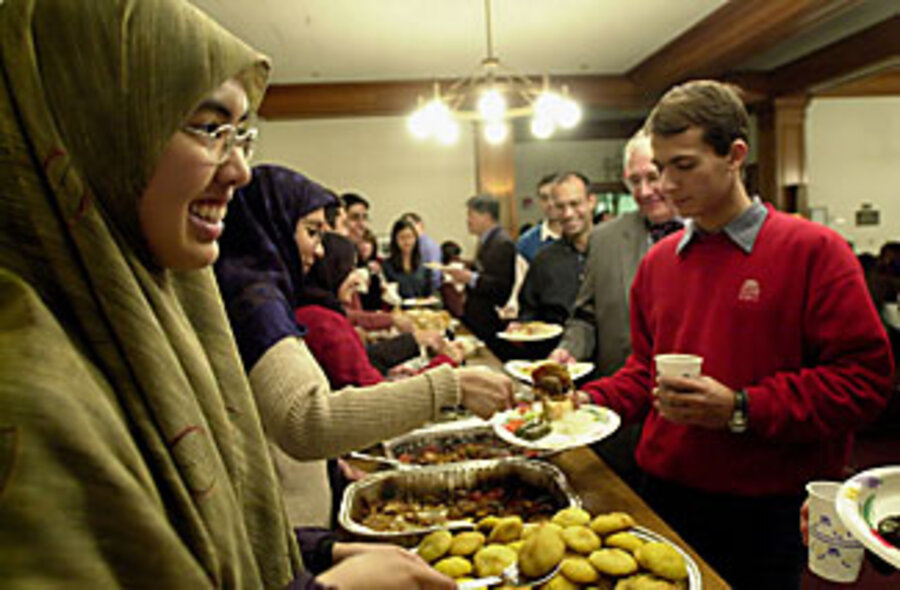Make way for Ramadan – in my fridge
Loading...
As the Southwestern desert heat gradually abates during the month of Ramadan, my annual venture into the unknown does not involve hiking outside the city limits of Tucson, Ariz., where I live. Rather, it involves contemplating the sticky recesses of my refrigerator.
What does Ramadan have to do with my refrigerator? Well, all during this month, Muslims worldwide fast during daylight hours in an effort to purify their daily lives. And I've come to realize that this cleansing should include my fridge, too. So my avoidance of scrubbing out this appliance, with its year's worth of lingering items, usually catches up with me just prior to Ramadan.
Before the month begins, I have to shop for foods that are traditional when breaking the daily fast. In my home, the two most important items for breaking the fast are dates and pakoras (a deep-fried fritter made of sliced potatoes, onions, spinach, and spices smothered in a batter of chickpea flour).
Since the Islamic calendar is lunar, the month of Ramadan has lately been progressing into summer. Dates are hard to come by in most stores during this time because they're out of season.
Fortunately, there is a great Middle Eastern grocery in town that stocks dates and pakora ingredients.
I must admit, oftentimes in years past, more of my focus has been on preparing the nightly Ramadan iftars (dinners) than on the job of cleaning out the ice box.
This year brings the same annoying dilemma as the past 29 years of fasting: To clean or not to clean? And what will I find in the refrigerator if I do try to clean it?
Years ago while scrubbing, I came across a curious growth in one vegetable bin.
Through economy, hoarding, or laziness – or maybe a bit of each – I had accumulated a fair amount of ketchup, tartar sauce, and minicreamers from various fast-food establishments.
One such freebie, a minicreamer that had somehow gotten punctured, had interacted with an open bag of almonds. A few of the almonds had sucked up the liquid and sprouted.
Imagine, I thought, a tree grows not only in Brooklyn but in my refrigerator as well.
While I have no desire to germinate any almond trees this year, I am stocking enough dates to tide us over at least until the end of the month.
First I purchase a 32-ounce container of deglet dates that will last two to three weeks. As the month proceeds, I usually need to buy another, but smaller portions are difficult to come by.
So, near the end of Ramadan, I inevitably end up with half a container or more of fresh dates. At first, this posed a problem. No one was interested in finishing them off, as eating them on a daily basis for 30 days had taken its toll.
But I didn't want them to go to waste, either. If they sat in the refrigerator for another year, they would be hard and unappetizing.
In a moment of levity, I considered going to a fast-food eatery for a small creamer so I could experiment with growing a date tree in my fridge. But I decided against it.
Instead, I pulled out my mother's weathered "First Ladies Cook Book," published in 1963, which contains the best date-cake recipe you could ever sink your teeth into.
I whipped up this dessert for our holiday of Eid al-Fitr, which follows directly after the month of fasting. When I first placed my desert on the tables of Eid goodies, along with baklava and other treats, some community members were pleasantly surprised that I, their fellow Muslim of Irish-American descent, could create such a delight. No longer. Now I am expected to attend Eid picnics with date cake in tow.
This Ramadan has been much the same as usual: a sticky refrigerator with a container half full of dates waiting for their day at the picnic.
Each year, the routines of pre-Ramadan shopping, daily fasting, and the high hopes of a spotless refrigerator remind me of my own personal journey. The journey of life, with all of its sticky messes and how my attempts and successes at sprucing up benefit not only my household appliance but my inner self as well.
French Orange Cake
1 (12-ounce) package dates, chopped fine
1 teaspoon baking soda
1/2 cup boiling water
1 cup sugar
1/2 cup shortening
1 egg
1 cup milk
2 cups flour
1/4 teaspoon salt
1/2 cup nuts
1-1/2 teaspoons orange rind, grated
Topping:
1/2 to 1 cup sugar
3/4 cup orange juice
Preheat oven to 325 degrees F.
Place chopped dates in a bowl, sprinkle baking soda over them, and pour boiling water over all. Let stand 30 minutes.
In a mixing bowl with an electric mixer, cream sugar and shortening. Add egg, milk, flour, and salt. Fold in nuts, orange rind, and date mixture until thoroughly mixed.
Pour into a greased 13-by-9-by-2-inch pan. Bake 50 minutes or until a toothpick inserted in center of cake comes out clean.
While cake is baking, place sugar and orange juice in a small saucepan and cook over low heat until sugar is dissolved. Pour over the hot cake. Place cake on a rack to cool. When cool, cut in squares and serve.
– Adapted from the 'First Ladies Cook Book,' compiled and edited by Mrs. Tim Babcock, Montana's first lady, 1963.





